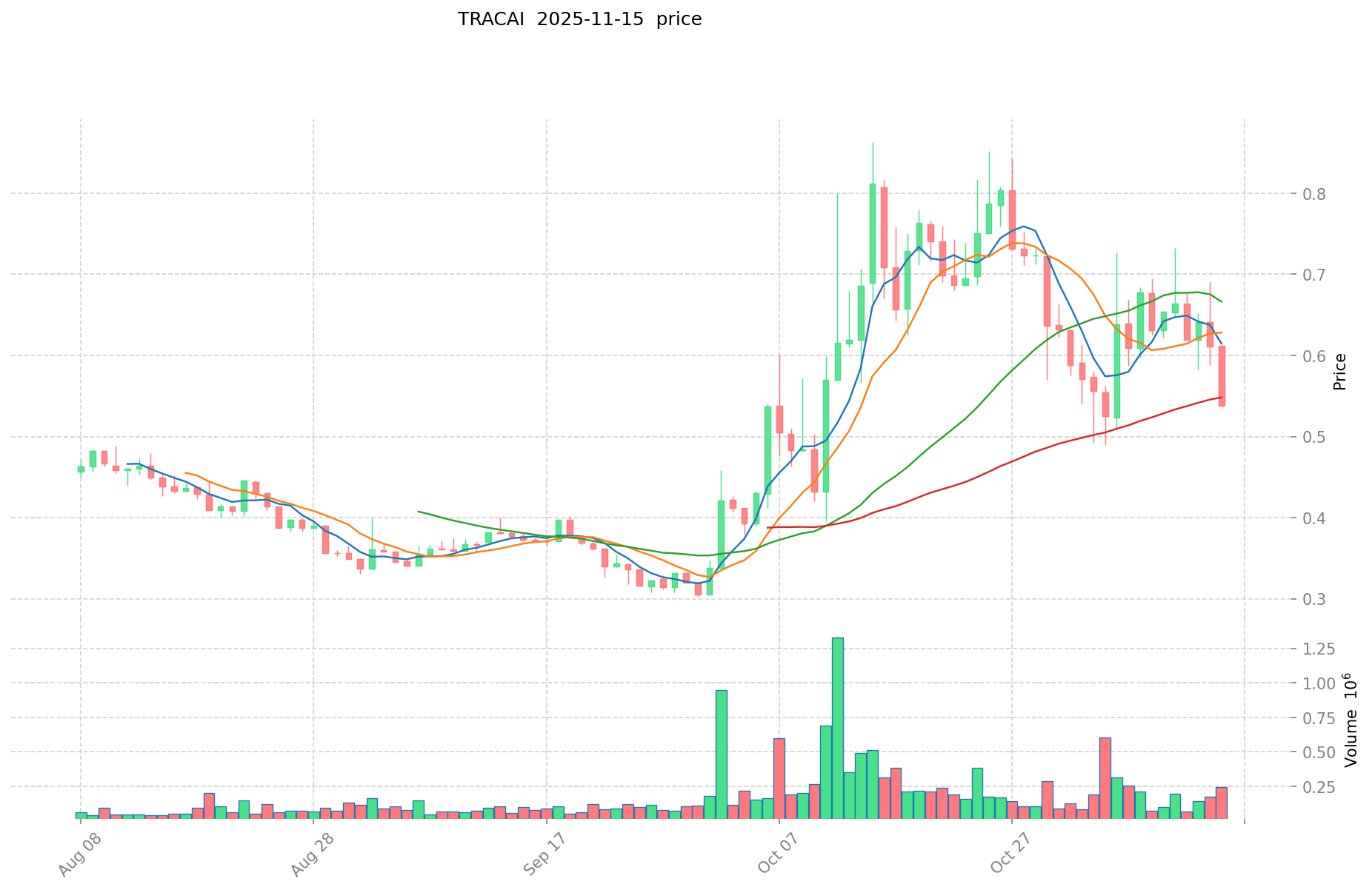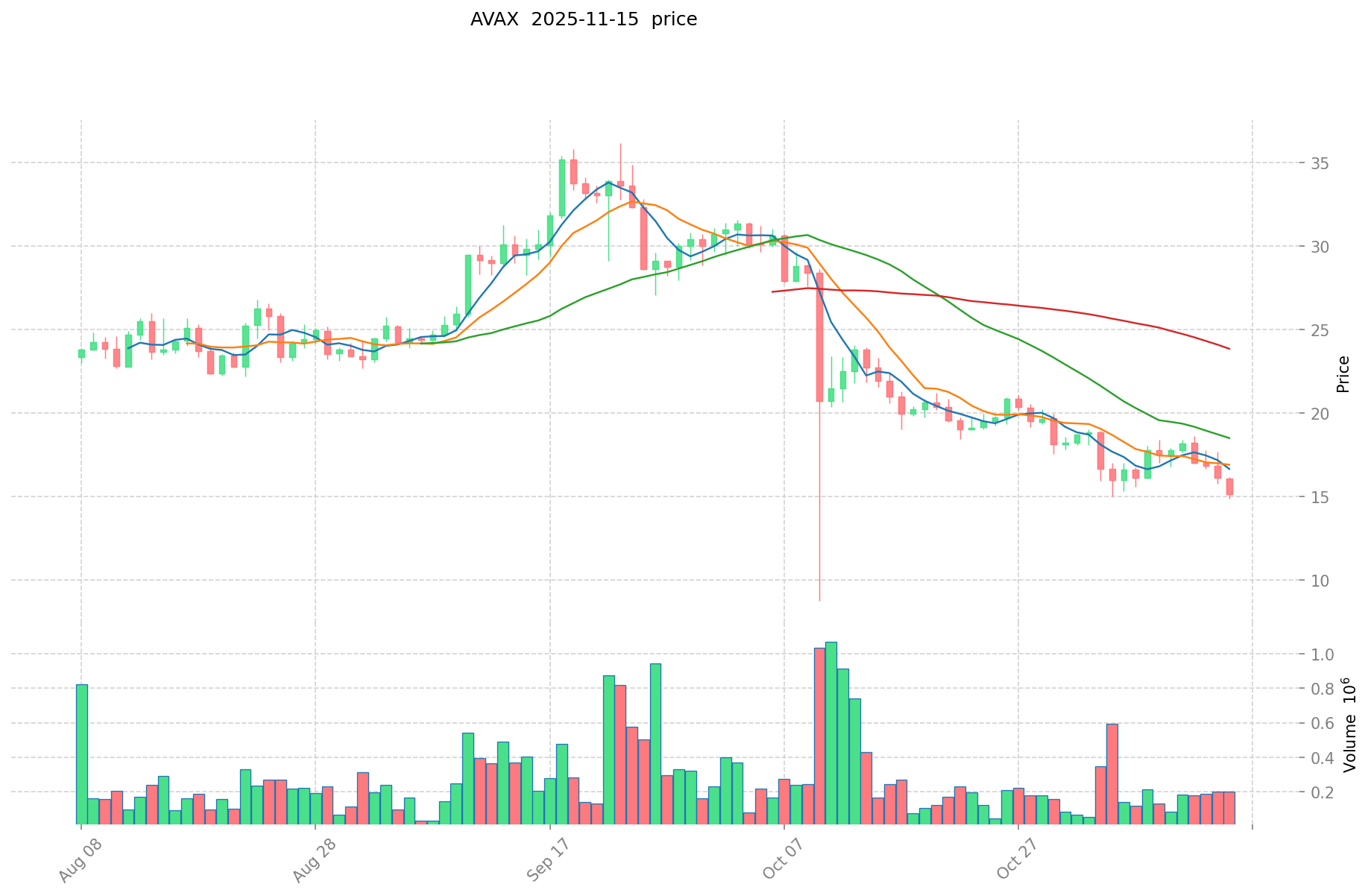TRACAI vs AVAX: Comparing Two Emerging Blockchain Platforms for DeFi Innovation
Introduction: TRACAI vs AVAX Investment Comparison
In the cryptocurrency market, the comparison between OriginTrail (TRACAI) vs Avalanche (AVAX) has been an unavoidable topic for investors. The two not only show significant differences in market cap ranking, application scenarios, and price performance, but also represent different positioning in crypto assets.
OriginTrail (TRACAI): Since its launch in 2018, it has gained market recognition for its role in building a Verifiable Internet for AI and combating misinformation.
Avalanche (AVAX): Introduced in 2020, it has been hailed as a platform for launching decentralized applications and interoperable blockchains, becoming one of the cryptocurrencies with high global transaction volume and market capitalization.
This article will comprehensively analyze the investment value comparison between TRACAI and AVAX, focusing on historical price trends, supply mechanisms, institutional adoption, technological ecosystems, and future predictions, attempting to answer the question most concerning investors:
"Which is the better buy right now?"
I. Price History Comparison and Current Market Status
TRACAI (Coin A) and AVAX (Coin B) Historical Price Trends
- 2024: TRACAI reached its all-time high of $1.2354 on December 9, 2024.
- 2025: AVAX experienced a significant decline, with its price dropping to $15.59 as of November 15, 2025.
- Comparative analysis: In the current market cycle, TRACAI has fallen from its peak of $1.2354 to $0.5495, while AVAX has dropped from its all-time high of $144.96 to $15.59, showing a more severe decline.
Current Market Situation (2025-11-15)
- TRACAI current price: $0.5495
- AVAX current price: $15.59
- 24-hour trading volume: TRACAI $76,656.68 vs AVAX $1,942,016.72
- Market Sentiment Index (Fear & Greed Index): 10 (Extreme Fear)
Click to view real-time prices:
- Check TRACAI current price Market Price
- Check AVAX current price Market Price


II. Core Factors Affecting the Investment Value of TRAC vs AVAX
Supply Mechanism Comparison (Tokenomics)
- TRAC: Fixed supply of 500 million tokens with no inflation; 60% of supply already circulating
- AVAX: Capped supply of 720 million tokens with a deflationary mechanism where transaction fees are partially burned
- 📌 Historical Pattern: Fixed supply tokens like TRAC tend to experience higher price volatility during market cycles, while AVAX's fee-burning mechanism creates continuous deflationary pressure potentially supporting long-term value.
Institutional Adoption and Market Applications
- Institutional Holdings: AVAX has gained more institutional traction with backing from firms like Andreessen Horowitz and Three Arrows Capital; TRAC has more niche enterprise partnerships
- Enterprise Adoption: TRAC focuses on supply chain tracking and enterprise data management while AVAX serves as a general-purpose blockchain platform for financial applications
- Regulatory Attitude: Both projects maintain regulatory compliance, though AVAX's higher market visibility has subjected it to greater regulatory scrutiny
Technical Development and Ecosystem Building
- TRAC Technical Upgrades: DKG (Decentralized Knowledge Graph) implementation enhances data integrity and interoperability; multichain strategy deployed across Ethereum, Polygon, and other networks
- AVAX Technical Development: Subnet architecture allows for customizable blockchains with flexible governance; C-Chain compatibility with Ethereum enables seamless dApp deployment
- Ecosystem Comparison: AVAX has a more developed DeFi ecosystem with significant TVL across lending protocols and DEXs; TRAC focuses on real-world data applications with implementations in pharmaceuticals, food tracing, and logistics
Macroeconomic Factors and Market Cycles
- Inflation Environment Performance: TRAC's fixed supply model theoretically offers stronger inflation resistance, while AVAX combines limited supply with active deflationary mechanisms
- Macroeconomic Monetary Policy: Both tokens tend to correlate with broader crypto market reactions to interest rate changes, though to varying degrees
- Geopolitical Factors: TRAC's supply chain focus makes it potentially valuable in global trade disruption scenarios; AVAX's financial infrastructure positioning makes it sensitive to regulatory shifts in major economies
III. 2025-2030 Price Prediction: TRACAI vs AVAX
Short-term Prediction (2025)
- TRACAI: Conservative $0.323 - $0.548 | Optimistic $0.548 - $0.647
- AVAX: Conservative $11.55 - $15.61 | Optimistic $15.61 - $17.80
Mid-term Prediction (2027)
- TRACAI may enter a growth phase, with an estimated price range of $0.518 - $0.908
- AVAX may enter a consolidation phase, with an estimated price range of $14.09 - $21.80
- Key drivers: Institutional capital inflow, ETF, ecosystem development
Long-term Prediction (2030)
- TRACAI: Base scenario $0.747 - $0.958 | Optimistic scenario $0.958 - $1.131
- AVAX: Base scenario $19.20 - $23.70 | Optimistic scenario $23.70 - $31.05
Disclaimer: This analysis is based on historical data and projections. Cryptocurrency markets are highly volatile and unpredictable. This information should not be considered as financial advice. Always conduct your own research before making investment decisions.
TRACAI:
| 年份 | 预测最高价 | 预测平均价格 | 预测最低价 | 涨跌幅 |
|---|---|---|---|---|
| 2025 | 0.646994 | 0.5483 | 0.323497 | 0 |
| 2026 | 0.68131758 | 0.597647 | 0.38847055 | 8 |
| 2027 | 0.9080648518 | 0.63948229 | 0.5179806549 | 16 |
| 2028 | 1.060069792133 | 0.7737735709 | 0.448788671122 | 40 |
| 2029 | 0.999444632852985 | 0.9169216815165 | 0.5501530089099 | 66 |
| 2030 | 1.130656125477996 | 0.958183157184742 | 0.747382862604099 | 74 |
AVAX:
| 年份 | 预测最高价 | 预测平均价格 | 预测最低价 | 涨跌幅 |
|---|---|---|---|---|
| 2025 | 17.7954 | 15.61 | 11.5514 | 0 |
| 2026 | 20.878375 | 16.7027 | 15.366484 | 7 |
| 2027 | 21.7970235 | 18.7905375 | 14.092903125 | 20 |
| 2028 | 21.10553172 | 20.2937805 | 19.279091475 | 30 |
| 2029 | 26.7025563819 | 20.69965611 | 12.6267902271 | 32 |
| 2030 | 31.0484491821945 | 23.70110624595 | 19.1978960592195 | 52 |
IV. Investment Strategy Comparison: TRACAI vs AVAX
Long-term vs Short-term Investment Strategy
- TRACAI: Suitable for investors focused on supply chain solutions and real-world data applications
- AVAX: Suitable for investors interested in DeFi ecosystems and blockchain infrastructure
Risk Management and Asset Allocation
- Conservative investors: TRACAI: 30% vs AVAX: 70%
- Aggressive investors: TRACAI: 60% vs AVAX: 40%
- Hedging tools: Stablecoin allocation, options, cross-currency portfolios
V. Potential Risk Comparison
Market Risk
- TRACAI: Higher volatility due to lower market cap and trading volume
- AVAX: Susceptible to broader crypto market trends and DeFi sector fluctuations
Technical Risk
- TRACAI: Scalability, network stability
- AVAX: Centralization of validators, potential security vulnerabilities
Regulatory Risk
- Global regulatory policies may impact both differently, with AVAX potentially facing more scrutiny due to its larger DeFi ecosystem
VI. Conclusion: Which Is the Better Buy?
📌 Investment Value Summary:
- TRACAI advantages: Niche focus on supply chain and data integrity, fixed supply tokenomics
- AVAX advantages: Established DeFi ecosystem, institutional backing, deflationary mechanism
✅ Investment Advice:
- New investors: Consider a balanced approach with a higher allocation to AVAX due to its established market presence
- Experienced investors: Explore TRACAI for its growth potential in the supply chain sector
- Institutional investors: Evaluate AVAX for its DeFi infrastructure and TRACAI for long-term enterprise adoption potential
⚠️ Risk Warning: The cryptocurrency market is highly volatile. This article does not constitute investment advice. None
VII. FAQ
Q1: What are the main differences between TRACAI and AVAX? A: TRACAI focuses on supply chain tracking and enterprise data management with a fixed token supply, while AVAX is a general-purpose blockchain platform for financial applications with a deflationary mechanism. TRACAI has a lower market cap and trading volume, while AVAX has more institutional backing and a developed DeFi ecosystem.
Q2: Which cryptocurrency has performed better historically? A: Based on the current data, TRACAI has shown better price retention from its all-time high. TRACAI has fallen from its peak of $1.2354 to $0.5495, while AVAX has dropped from $144.96 to $15.59, indicating a more severe decline for AVAX.
Q3: How do the tokenomics of TRACAI and AVAX compare? A: TRACAI has a fixed supply of 500 million tokens with no inflation, and 60% of the supply is already circulating. AVAX has a capped supply of 720 million tokens with a deflationary mechanism where transaction fees are partially burned.
Q4: What are the key factors affecting the investment value of TRACAI and AVAX? A: Key factors include supply mechanisms, institutional adoption, market applications, technical development, ecosystem building, and macroeconomic factors such as inflation and monetary policy.
Q5: What are the price predictions for TRACAI and AVAX in 2030? A: For TRACAI, the base scenario predicts a range of $0.747 - $0.958, with an optimistic scenario of $0.958 - $1.131. For AVAX, the base scenario predicts $19.20 - $23.70, with an optimistic scenario of $23.70 - $31.05.
Q6: How should investors allocate their portfolio between TRACAI and AVAX? A: Conservative investors might consider allocating 30% to TRACAI and 70% to AVAX, while aggressive investors might allocate 60% to TRACAI and 40% to AVAX. However, individual risk tolerance and investment goals should guide these decisions.
Q7: What are the potential risks associated with investing in TRACAI and AVAX? A: Risks include market volatility, technical challenges (such as scalability for TRACAI and validator centralization for AVAX), and regulatory uncertainties. AVAX may face more regulatory scrutiny due to its larger DeFi ecosystem.
Q8: Which cryptocurrency might be better for new investors? A: New investors might consider a balanced approach with a higher allocation to AVAX due to its established market presence and more developed ecosystem. However, individual research and risk assessment are crucial before making any investment decisions.
Share
Content